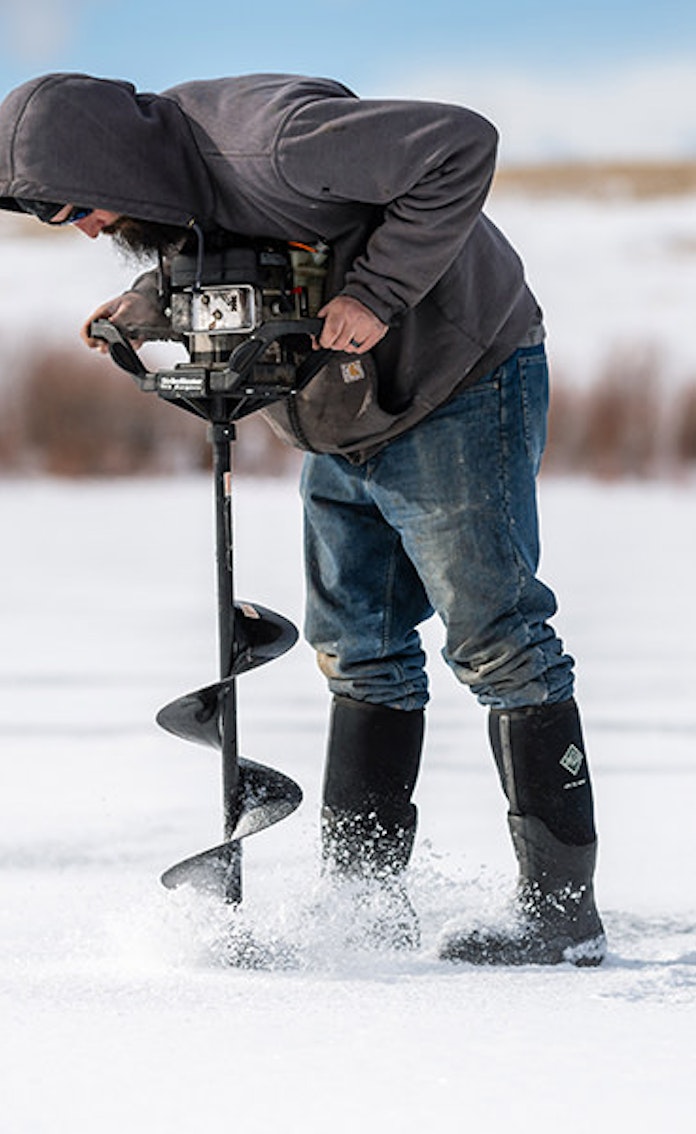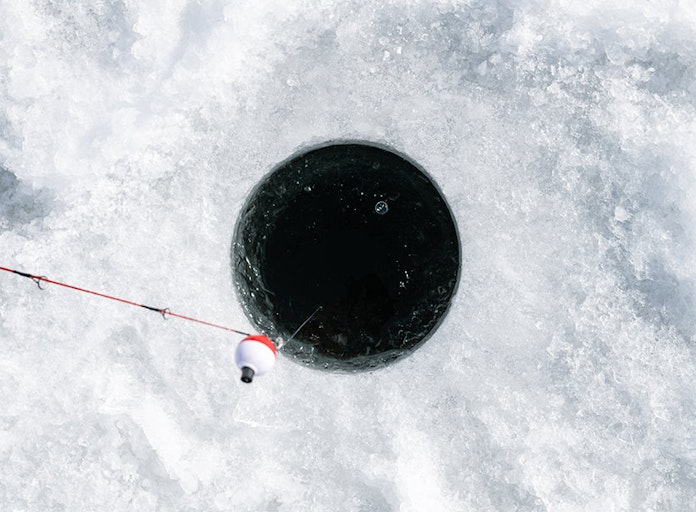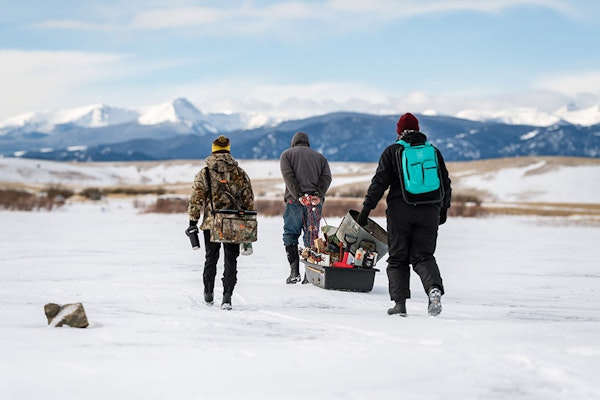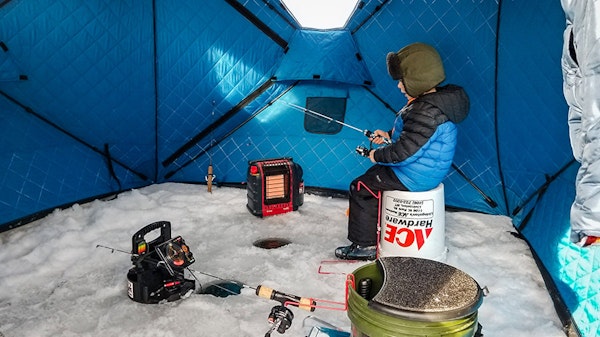From its inception, the Buck Knives brand has been rooted in self-reliance, grit, and innovation. In a similar spirit of self-sufficiency and tenacity, a select group of thick-skinned individuals ceremoniously gather on weekends to pass the cold days of winter. While others lounge around televisions watching football in their heated homes every Sunday, ice fishermen gather around a small hole in the ice, weathering arctic winds, and spending time with family and friends.

“It’s like you’re on a different planet when you’re out in the middle of a frozen lake. You’re standing on frozen water, and all around you are big expanses of flat, wide open space,” says Brian Lindquist.
Brian grew up in Beaver Dam, a small town in Wisconsin known for a long tradition of ice fishing. All throughout high school, he spent his weekends ice fishing with his friends and their families – hanging out in the “shanty towns” that were left up on the ice all winter long.
“It was a magical little scene, being a teenager and feeling like you’re in your own little world,” he says.

Like most types of fishing, ice fishing evolved not for sport but out of necessity for survival when food was scarce during the cold winter months. The first ice fishermen in the United States were likely Native American tribes in the Midwest, who chipped away at the ice with handmade tools and used spears to hunt fish. Since then there have been many innovations in ice fishing tools and techniques, and while the sport still revolves around sitting out on a frozen lake for hours, there are many comforts that can make it more enjoyable than it once was.

If you live in the northern half of the country, there’s a good chance you’re close to some good ice fishing spots, though they may not be as abundant and accessible as in Brian’s childhood stomping grounds.
“In Wisconsin, there’s lakes everywhere…you drive down the highway and you pass lake after lake, and just about every single one has little communities of ice shanties – anywhere from twenty to one-hundred ice huts,” says Brian. “It’s pretty much an exact scene from Grumpy Old Men.”

Unlike the scenes from Grumpy Old Men, new technology, motivated by what was likely many generations of very cold, very hungry people, now allows for zipping across frozen lakes on snowmobiles, ice shanties so warm you might have to drop some layers, and portable televisions to allow for the aforementioned Super Bowl viewing. Most ice fishermen, like Brian, are out there for the old-school experience –a love for the outdoors, the sport of fishing, and some fresh (albeit cold) air.



Though it’s relatively safe as long as you’re using good judgement, ice fishing comes with some inherent risk. There’s no such thing as completely safe ice, it melts and cracks and has varying degrees of strength and thickness. Never fish over moving water. Four inches of clear ice is considered safe to walk on, while six inches will support an ATV or snowmobile. To drive a truck onto the ice, there should be a solid foot of good, stable ice. Check in with the local bait shops or the Fish and Game office for up-to-date ice reports. Lakes and ponds will have specific regulations for ice fishing, like catch-and-release rules, or restrictions on live bait, so be sure to know before you go.
When Brian moved to Livingston, Montana, he continued to ice fish, taking a trip out to Fort Peck every winter with a group of friends to fish his favorites: walleye, bass, perch, and pike.


If you’re new to the sport, you don’t need a lot of equipment to get started, especially if you’re already an open-water angler. As with most outdoor sports, making friends with a local of the area you’re in always helps your luck. For the basics, you’ll need an auger or drill attachment to cut the hole in the ice, an ice fishing rod, some artificial lures (like tungsten jigs, teardrop jigs, spoons, and jigging raps – all of which can be baited with wax worms), safety spikes for your boots, warm clothes, and a good attitude towards winter weather.
Notably, Brian has a tattoo of a tip-up, a tool used to notify an angler when there’s a fish on the line, on his arm.
“It’s my favorite tool in the world,” he says. “Firstly because it represents my heritage. Beaver Dam, Wisconsin is the birthplace of the most famous and best tip-ups. And secondly, it represents the ingenuity and creativity of the ice fishing culture – it’s one of the things that drew me to it. The tip-up is a simple tool but it’s also quite genius. Ice fishermen are a unique subculture of people, they’re generally very friendly, out there braving the cold and the elements and enjoying each other’s company. It’s a very self-sufficient culture of people.”

One of Brian’s favorite things about tip-ups is when the flag pops up – notifying you that a fish is biting.
“It’s like the start of a little party,” he says. “Everyone gathers around and cheers, and jokes around and coaches the person who is landing the fish, whether they want it or not. The moment is filled with good camaraderie and excitement.”
A few years ago, Brian was out north of White Sulfur Springs, fishing a little mountain lake with his seven-year-old son, Reid, and some friends. The flag went up on their tip-up and Reid went to take it. He started pulling the line up and fighting the fish.

“We could tell it was a big fish by the way it was pulling,” laughs Brian. “We finally got it out of the hole and it was a giant burbot fish.”


Brian says every ice fisherman he’s ever known who has caught one says it scares them half to death when they see a burbot fish come out of the hole.
“We got it on the ice and my son was so excited. He wanted to keep it, and while normally I would have let a big fish like that go, I let him take it home. When we got home and I went to filet it, I noticed there was something in its stomach. Sure enough, there was a full 12-inch rainbow trout with the lure in its mouth,” he says.

Though there are more comfortable things to do than to sit in a shelter the size of an airplane bathroom on some of the coldest days of winter, Brian continues his own legacy of ice fishing, and is successfully passing down his love for the sport to his two children. He says it’s a nice escape to share the coziness of an ice shanty with his family without the distractions of the outside world.
“Ice fishermen are out there in the cold, braving the elements and working as a team – sharing knowledge and helping each other succeed – life lessons we want our kids to be exposed to,” he says.




